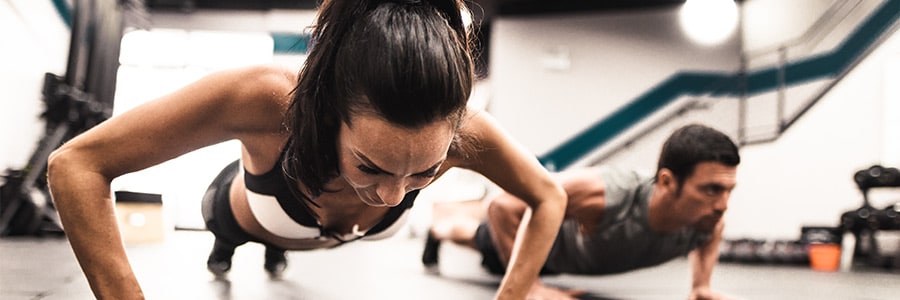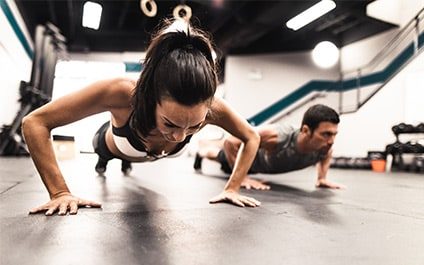
Many people attack certain exercise moves wither before they’ve had proper training or before they have the strength in the right places to perform the moves properly and safely. Social media and Youtube, as well as your app store, are great places for at-home workouts, but for someone who is not experienced in exercise or someone’s starting out, these can be dangerous, as there is no one with you to correct form and keep you in a safe position. Check out some of the most common moves done improperly… read these then find a mirror to check your form so you can do this right in your next inBalance class!
Squats
Tight, fit, round booties are super trendy right now and everyone is looking for a good workout to get an apple bottom. Enter the SQUAT. You can do this with weights, without weights, with legs in different positions, but the goal is the same: work and strengthen the back side. A traditional squat is done with the heels about hip width distance apart, then bend the knees to drop your rear towards the ground; drive through the heels to come back up to stand.
The problem here is twofold. First, many people jump to the squat rack too quickly; instead, they should try to master air squats (a squat with just your body weight) first, as well as just proper engagement of the posterior chain ( the back side). When people jump right to the weights, their form and musculature is, in many cases, not strong enough to perform the movement properly. This leads to the next problem of correct muscle engagement. When loading weights on a bar to do squats before knowing the correct movement, the squat can go straight to the low back (DEFINITELY not what you are going for); I see this when people lead with their chest (dip their chest forward) rather than lead with their hips (sit their butts low to the ground). An incorrect squat can also can harm the knees, as the knees can roll in over the big toe, rather than staying lined up over the middle toes. Correct form here requires strong adductors (inner thighs) as well as glutes and hamstrings.
Crunches or abdominal exercises
Everyone wants a flat tummy, so we do all the abdominal exercises we can muster, and, at some point, this will include some variation of a crunch. Doing crunches incorrectly, leads to neck problems, and in some women, can exacerbate diastasis recti (the separation of the abdominals). I see this when I see people pulling SO hard with their arms to get their neck off the floor, or they are jamming their chin into their chest and just lifting their head. Instead, keep the elbows out to the side and have LIGHT pressure on the back of the head, keep a small space between the chin and the chest, and instead of leading with the chin or the head, think of engaging the abdominals to get the shoulders blades off of the floor. Doing this exercise in this position, i like to use the term “chest lift” in my classes, instead of crunch, so it emphasizes the lifting of the chest rather than the head or the neck. The breath is also important when doing a chest lift, or any variation. Exhaling on the lift ( on the exertion) helps to draw the belly button into the back as you lift the chest, thus activating the transverse abdominals (or TA, the deep abdominal muscles) rather than just focusing on the external rectus abdominals. Working the TA is what gives you the flat belly and strong core, and this factor is critical for ladies with diastasis recti, as the TA is what must be strengthened to correct and heal the separation of the abs.
Push ups or moves in a push up position
Push ups are, many times, the go-to for a quick upper body workout. While these are great for the upper body and the core, the are most often times done incorrectly. Their are a few important things to note about body placement when doing a push up correctly. First, wrists should always be lined up underneath the shoulders, to prevent too much strain on the shoulders and keep the work in the pectorals (chest muscles). Next, the lats (those muscles on the outside of the back to the sides of the body) should be engaged, which will help keep shoulder blades apart. Keeping the shoulder blades protracted ensures that your push up is working the chest and muscles around the front of the body, rather than getting into the neck and shoulders. And finally, your push up should also be a core workout. This means that the muscles around the midsection, back and front, should be working. When they are not engaged, the belly will sink down and there is a sway in the back; when the upper body in engaged correctly, there will be a straight line from the head down to the tailbone. An ta-da! A perfect push up!
Planks (on elbows)
A proper plank goes hand in hand with a correct push up. The core is key here. Just like a push up, if done incorrectly, the low back will sink in and there will be a sway in the back, which puts all the work in the low back as well as the shoulders. To get the back in the correct position, I tell my clients to pull their pubic bone up towards the belly button, which then lengthens the low back and brings the work in to the abs instead of the back. In addition, as with a push up, the shoulder blades should remain protracted (pulled apart). Once you sink down into the shoulder blades, the work goes out of the abs and into the upper body, which is not the goal in this exercise! Instead, think of pushing away from the floor, pulling the shoulder blades apart.

